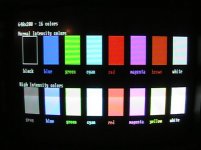EddieDX4
Veteran Member
Even the EGA card with the CGA monitor was light years ahead of having a CGA card. I didn't own a PC in the 80s, but I definitely would have rather had Hercules than a CGA setup.
For a while, I ran a machine with an EGA card and a Tandy CM-11 CGA monitor. It supported 320x200 16 color EGA mode, and the rare 640x200 16 color mode that some applications had (hmm, I think PC Paintbrush or whatever it was called supported this). Unfortunately, the aspect ratio made everything look hedious in 640x200.




